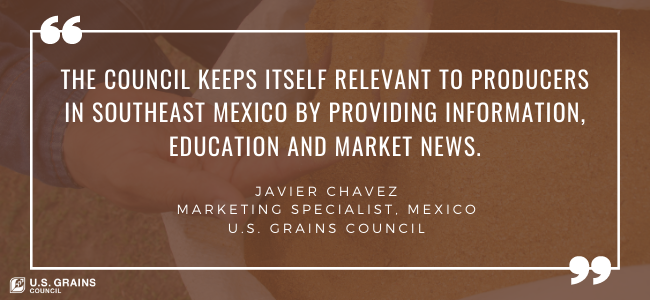The U.S. Grains Council (USGC) took cattle ranchers in southeast Mexico on a virtual tour of the production of corn, ethanol and distiller’s dried grains with solubles (DDGS) in Indiana in late August.
The virtual trade team provided an overview of U.S. ethanol and DDGS production and procurement as well as the latest on U.S. corn crop conditions. The activity is part of the Council’s work to continue promoting U.S. DDGS in the region despite COVID-19-related restrictions on the organization’s in-person feeding trials and market development work in the relatively remote region of Mexico.
“The visit helped these producers see firsthand how DDGS is manufactured and gain confidence in the supply of the co-product,” said Javier Chavez, USGC marketing specialist in Mexico. “These participants have never been on a Council-sponsored program, so this was the first time that many of them have seen an ethanol plant.”
The Council collaborated with Indiana Corn and Cardinal Ethanol to put the program together. The virtual trade team included videos of corn in the field and discussions of the DDGS production process at an ethanol plant. The corn farmers who participated both in the video presentations and live question-and-answer sessions also raise cattle and dairy cows, which added to an exchange on the use of DDGS in bovine diets.
“Everyone put in their grain of sand,” Chavez said. “The team experience offered greater confidence and security for cattle producers to use DDGS and obtain better productive and economic performance in their cattle.”
Most attendees were small to medium-sized cattle producers, but some local feed consultants and universities staff also participated. Because the virtual trade team included farmers discussing their field conditions in Indiana, the Council also included the main grain buyer in the Yucatan Peninsula and Mexico’s biggest swine producers, which are located in the region.
“Since the Southeast Mexico market is divided into small producers, we would have not brought them to the United States on a mission under normal conditions,” Chavez said. “Video platforms have provided an opportunity to bring the U.S. grain value chain to them so they can ask important questions and interact with U.S. farmers, grain traders and others.
“The activity demonstrated that there is substantial infrastructure behind DDGS, assuring these customers of the product’s quality and supply over the long-term.”
Reinforcing that U.S. DDGS supplies remain available is especially important as the region experienced shortages or non-competitive pricing in April and May due to the U.S production shortfall related to the outbreak of COVID-19 and an increase in the exchange rate between the U.S. dollar and the Mexican peso. After purchases of the feed ingredient fell essentially flat in April and May, exports to southeast Mexico are regaining strength.
While these sales are small compared to the northern Mexican market, they continue to represent an area of growth and expansion for U.S. exports. The Council’s strategy in the region had been very hands-on, relying on field trials with key industry stakeholders and direct follow-ups that promote a snowball of demand building. When travel restrictions were imposed, the Council and consultants Ruben Aguilera Sosa and Eduardo Christensen immediately started to brainstorm alternative methods to keep in contact with end-users and distributors.
“Our work in Southeast Mexico has been affected – like all activities in the world – by COVID-19,” Chavez said. “However, thanks to teamwork, we have developed and sent informative capsules about DDGS via WhatsApp and conducted video conferences like this program via Zoom that have allowed us – from home – to continue promoting the productive and economic benefits of DDGS for cattle production.”
When possible, the Council will resume in-person visits to these producers on their ranches and to continue with feeding trials. The Council is also planning on expanding both virtual and future in-person projects to reach out into other relatively remote areas of Mexico and into Belize.
“The Council keeps itself relevant to producers in Southeast Mexico by providing information, education and market news,” Chavez said. “There is still plenty to do and the Council will stay in contact with DDGS producers, technicians, marketers and end-users through all means possible to keep the nutritional and economic benefits of DDGS supplementation at the forefront of their minds and their operations.”
Learn more about the Council’s work to promote U.S. DDGS in Mexico.
About The U.S. Grains Council
The U.S. Grains Council develops export markets for U.S. barley, corn, sorghum and related products including distiller’s dried grains with solubles (DDGS) and ethanol. With full-time presence in 28 locations, the Council operates programs in more than 50 countries and the European Union. The Council believes exports are vital to global economic development and to U.S. agriculture’s profitability. Detailed information about the Council and its programs is online at www.grains.org.

